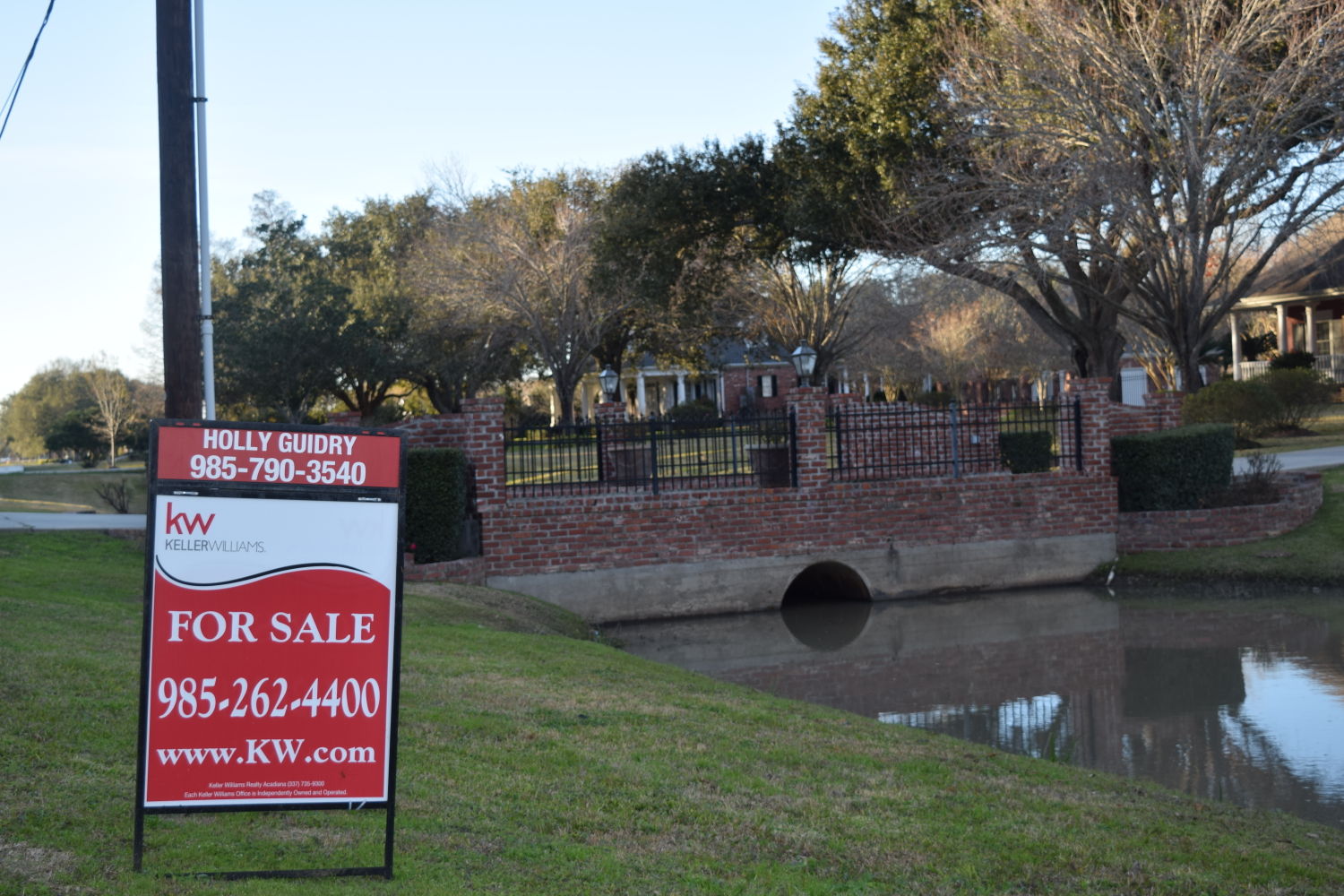
Krewe de Bonne Terre moves parade to Sunday
February 5, 2016
Mardi Gras morning hit and run proves fatal
February 10, 2016The low price of oil’s effects on the Bayou Region can be seen in every part of the local economy.
Many companies related to oil exploration and production have cut workers’ jobs or hours. Parish governments are seeing drops in revenue from sales taxes and mineral royalties.
The downturn has not spared the housing market in Terrebonne and Lafourche parishes, either. Housing permits in Terrebonne Parish decreased in 2015. A report by Nationwide Insurance ranked the Houma-Thibodaux metropolitan statistical area among the weakest in the nation.
However, local and national officials have found reasons for optimism within those same housing figures from the last year. They see a market that is currently lacking growth, but is showing resilience in light of the struggling energy sector. Observers say the area still looks primed for growth when the price of oil rebounds.
Permits down, but not out
Geoffrey Large, assistant director of planning and zoning in Terrebonne Parish, provided housing permit figures from the previous four years. Terrebonne gave out fewer permits for single-family homes, commercial developments and commercial renovations in 2015 than they did in any of the previous three years. Mobile home permits stayed the same at 128 in both 2015 and 2014.
Terrebonne gave out 211 permits for new single-family homes in 2015, down from 242 in 2014. The average unit cost also dropped from about $274,000 to $267,000. The 2015 figures mark a four-year decline in single-family home permits since the 291 Terrebonne granted in 2012. However, average unit cost in 2015 was about $159,000, considerably less than the following three years.
Terrebonne’s 93 commercial development permits in 2015 also marked a four-year low. However, data indicates that the value of the work in 2015 went up from the previous year.
The average unit cost in 2015 commercial developments was about $791,000, compared to about $766,000 in 2014. It is a far cry from the 2013 high of more than $1 million per development, but still much higher than the average unit cost of $327,000 in 2012.
The parish’s 118 commercial renovation permits given in 2015 is a considerable decrease from 157 in 2014 and the four-year high of 207 in 2012. Again, data reveals a huge jump in the cost of work after that first year. In 2012, average unit cost on commercial renovation was about $59,000.
Even with 44 fewer permits given out in 2013, the total value of construction more than doubled, as average unit cost almost tripled to about $168,000. That figure dropped back down to about $116,000 in 2014 and stayed just about the same in 2015.
Large said the coast’s vulnerability to storms has caused skyrocketing construction costs. The assistant director said in an email that construction costs can jump in the wake of storms. He also pointed to the push to elevate homes in 2013 as another factor for its jump.
“Whenever there is disaster recovery-led construction, the costs of materials and labor rise, because of shortages and opportunism. This results in an artificial increase in construction costs for those periods,” he wrote.
Large also pointed to the upward pressure that storms have on permit numbers given out in a year. He mentioned 2002’s Hurricane Lily leading to a spike in 2003. Hurricanes Katrina and Rita’s double tap in 2005, combined with delays related to the large number of claims, resulted in increased activity from 2006 to 2009, with Gustav and Ike also contributing to 2008-09. Large parses out those years affected by storms to find signs of hope for the parish’s 2015.
“If you isolate these disaster effects from the long term trend, 2015 was actually the [fifth] best year for construction investment in the parish since 1993, a 23-year period,” Large wrote. “This was achieved despite the 2015 impact of falling oil prices in an economy that is, to a significant extent, dependent of the prosperity of the oil industry. I believe that this speaks to our being well placed for economic expansion when oil prices return to more normal levels.”
Nationwide ranks MSA low
The Bayou Region housing market did not receive high marks from a Nationwide Insurance report rating 400 markets in the United States. The Health of Housing Market Report listed the Houma-Thibodaux MSA among the bottom 10 in the country, coming in at number 391 out of 400. Both the Hammond and New Orleans-Metairie MSAs came in ranked below Houma-Thibodaux, with New Orleans-Metairie ranked last overall.
The report looked at each MSA’s employment, demographics, mortgage market and house prices to assess the health of each housing market. While the Bayou Region was ranked low, the report did not foresee a housing decline in the area. Instead, Houma-Thibodaux received a neutral performance ranking, ranked low because of robust housing market growth in the rest of the country. The New Orleans-Metairie MSA was the only one in the study to receive a negative grade.
The MSAs joining Houma-Thibodaux in the bottom 10 are mostly comprised of other areas with economies tied to the oil industry. Nationwide Senior Economist Ben Ayers pointed to the dropping oil prices as a cause for concern in the local market.
“You’re seeing job losses over the past year. You’re seeing unemployment rates increase. You’re seeing cutbacks in the number of households formed. Maybe some people are leaving the area; maybe they’re going somewhere else to find a job. All those kind of demand metrics are not doing as well, mainly because of the downturn in the oil prices,” Ayers said.
While the Nationwide report fretted about the downturn’s effect on demand in the area, one group of commercial developers sees a growing need for affordable housing in the region. The Renaissance Neighborhood Development Corporation, a subsidiary of the Volunteers of America, have two developments in the Houma area. The RNDC completed the Bayou Cane Apartments in the spring of 2015, and just broke ground on the Houma School Apartments, which is a revamp of the old Houma Elementary School on Grinage Street.
The Bayou Cane property has 82 one- and two-bedroom units of workforce housing, while the Houma School Apartments will have 103 low-cost units for seniors. RNDC Director of Property Management Jason Strealy said Bayou Cane is currently at 93 percent occupancy, with a goal to reach 100 percent by the end of February and stay above 95 percent in the long term. The goal for the Houma School Apartments is to open in the spring next year and complete the lease up before the end of 2017.
Strealy said the need for low-cost living in the area has drawn in residents from all of Terrebonne.
“The biggest surprise for me has been the pent-up demand for affordable housing units. This demand was not just isolated to Houma itself, as Bayou Cane has drawn residents from Houma all throughout the parish,” he said.
Ayers pointed to the economic downturn as a call for the area to diversify its economy so that these dips in oil price do not have such far-reaching effects in the future. However, he pointed to the area’s current situation as a sign of progress by placing it contrast to the 1980s downturn.
“The main thing is to try to diversify the employment opportunities as much as possible, so next time you get a downturn in oil, it’s not quite as impactful. But certainly it’s not as impactful as the big declines in the ‘80s,” he said. “I think things have already diversified, moved in that direction right now. It’s just that’s the nature of the beast, that’s the key industry down there, and it’s going to have some impact on things.”
Ayers did point to housing affordability in the region as the report’s silver lining. He said that there have been positive house price gains that have stayed sustainable and in line with income. According to Ayers, this is a sign of promise for after Terrebonne weathers this economic storm.
“You’re seeing very affordable markets down there. It should mean once things turn around for oil, that should be a good source of growth for the local housing market going forward,” he said.
Bayou Board still sees positive signs
While figures for permits and employment have taken hits with the oil economy, housing sales have not seen a big hit, according to the Bayou Board of Realtors.
The group represents realtors from Terrebonne, Lafourche, St. Mary and Assumption Parishes. According to Joe Boudreaux, the 2016 president of the Bayou Board, his organization is confident in the current market and its future.
Boudreaux looked at his organization’s sales figures from the last three years, and the figures show a stable market. In 2013, Bayou Board realtors sold 1,180 homes at an average price of $172,000, with those homes staying on the market for an average of 144 days. Those figures stayed consistent the next year, when realtors sold 1,176 homes. The average price dropped a bit to about $169,000, and the average home spent 141 days on the market. In 2015, realtors sales jumped to 1,231, while the average price increased a tiny amount to $170,000. Homes spent 138 days on the market on average last year.
The Bayou Board president said his organization does not view any market as bad, but instead as somewhere in the cycle of shifting from a buyer’s to a seller’s market. According to Boudreaux, the region looks headed to a buyer’s market.
“We are very, very positive that this market will be just fine. It’s going to shift into a buyer’s market. All the factors are there that say that it will. But a buyer’s market is not a bad thing. It is just a cycle of it, and as long as our property owners understand, the members of the Bayou Board of Realtors are here to help in any way we can,” he said.
Boudreaux noted that a buyer’s market presents its own challenges for realtors, but the core issue remains: they must find the sweet spot in pricing where both sides want to make a deal.
“Especially in a buyer’s market, our realtors need to have their eye on the market, they need to know how to price the home correctly,” he said. “If it’s priced right, it will sell. That’s it. We just have to be more vigilant, and watch the market more closely on a daily basis.”•













